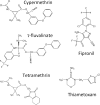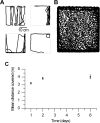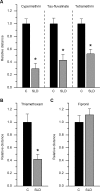A Locomotor Deficit Induced by Sublethal Doses of Pyrethroid and Neonicotinoid Insecticides in the Honeybee Apis mellifera
- PMID: 26659095
- PMCID: PMC4682844
- DOI: 10.1371/journal.pone.0144879
A Locomotor Deficit Induced by Sublethal Doses of Pyrethroid and Neonicotinoid Insecticides in the Honeybee Apis mellifera
Abstract
The toxicity of pesticides used in agriculture towards non-targeted organisms and especially pollinators has recently drawn the attention from a broad scientific community. Increased honeybee mortality observed worldwide certainly contributes to this interest. The potential role of several neurotoxic insecticides in triggering or potentiating honeybee mortality was considered, in particular phenylpyrazoles and neonicotinoids, given that they are widely used and highly toxic for insects. Along with their ability to kill insects at lethal doses, they can compromise survival at sublethal doses by producing subtle deleterious effects. In this study, we compared the bee's locomotor ability, which is crucial for many tasks within the hive (e.g. cleaning brood cells, feeding larvae…), before and after an acute sublethal exposure to one insecticide belonging to the two insecticide classes, fipronil and thiamethoxam. Additionally, we examined the locomotor ability after exposure to pyrethroids, an older chemical insecticide class still widely used and known to be highly toxic to bees as well. Our study focused on young bees (day 1 after emergence) since (i) few studies are available on locomotion at this stage and (ii) in recent years, pesticides have been reported to accumulate in different hive matrices, where young bees undergo their early development. At sublethal doses (SLD48h, i.e. causing no mortality at 48 h), three pyrethroids, namely cypermethrin (2.5 ng/bee), tetramethrin (70 ng/bee), tau-fluvalinate (33 ng/bee) and the neonicotinoid thiamethoxam (3.8 ng/bee) caused a locomotor deficit in honeybees. While the SLD48h of fipronil (a phenylpyrazole, 0.5 ng/bee) had no measurable effect on locomotion, we observed high mortality several days after exposure, an effect that was not observed with the other insecticides. Although locomotor deficits observed in the sublethal range of pyrethroids and thiamethoxam would suggest deleterious effects in the field, the case of fipronil demonstrates that toxicity evaluation requires information on multiple endpoints (e.g. long term survival) to fully address pesticides risks for honeybees. Pyrethroid-induced locomotor deficits are discussed in light of recent advances regarding their mode of action on honeybee ion channels and current structure-function studies.
Conflict of interest statement
Figures



Similar articles
-
In vitro effects of thiamethoxam on larvae of Africanized honey bee Apis mellifera (Hymenoptera: Apidae).Chemosphere. 2015 Sep;135:370-8. doi: 10.1016/j.chemosphere.2015.04.090. Epub 2015 May 15. Chemosphere. 2015. PMID: 25985214
-
Effects of sublethal doses of acetamiprid and thiamethoxam on the behavior of the honeybee (Apis mellifera).Arch Environ Contam Toxicol. 2008 May;54(4):653-61. doi: 10.1007/s00244-007-9071-8. Epub 2007 Nov 17. Arch Environ Contam Toxicol. 2008. PMID: 18026773
-
Cytotoxic effects of thiamethoxam in the midgut and malpighian tubules of Africanized Apis mellifera (Hymenoptera: Apidae).Microsc Res Tech. 2014 Apr;77(4):274-81. doi: 10.1002/jemt.22339. Epub 2014 Jan 27. Microsc Res Tech. 2014. PMID: 24470251
-
Systemic insecticides (neonicotinoids and fipronil): trends, uses, mode of action and metabolites.Environ Sci Pollut Res Int. 2015 Jan;22(1):5-34. doi: 10.1007/s11356-014-3470-y. Epub 2014 Sep 19. Environ Sci Pollut Res Int. 2015. PMID: 25233913 Free PMC article. Review.
-
A critical review of neonicotinoid insecticides for developmental neurotoxicity.Crit Rev Toxicol. 2016 Feb;46(2):153-90. doi: 10.3109/10408444.2015.1090948. Epub 2015 Oct 29. Crit Rev Toxicol. 2016. PMID: 26513508 Free PMC article. Review.
Cited by
-
Pyriproxyfen Exposure Impairs Cognitive Parameters and Alters Cortisol Levels in Zebrafish.Front Behav Neurosci. 2020 Jun 17;14:103. doi: 10.3389/fnbeh.2020.00103. eCollection 2020. Front Behav Neurosci. 2020. PMID: 32625070 Free PMC article.
-
Honey Bee Proteolytic System and Behavior Parameters under the Influence of an Electric Field at 50 Hz and Variable Intensities for a Long Exposure Time.Animals (Basel). 2021 Mar 18;11(3):863. doi: 10.3390/ani11030863. Animals (Basel). 2021. PMID: 33803600 Free PMC article.
-
Resistance and Vulnerability of Honeybee (Apis mellifera) Gut Bacteria to Commonly Used Pesticides.Front Microbiol. 2021 Sep 3;12:717990. doi: 10.3389/fmicb.2021.717990. eCollection 2021. Front Microbiol. 2021. PMID: 34539609 Free PMC article.
-
Neonicotinoid-induced impairment of odour coding in the honeybee.Sci Rep. 2016 Dec 1;6:38110. doi: 10.1038/srep38110. Sci Rep. 2016. PMID: 27905515 Free PMC article.
-
Modelling daily weight variation in honey bee hives.PLoS Comput Biol. 2023 Mar 1;19(3):e1010880. doi: 10.1371/journal.pcbi.1010880. eCollection 2023 Mar. PLoS Comput Biol. 2023. PMID: 36857336 Free PMC article.
References
-
- Chauzat MP, Faucon JP. Pesticide residues in beeswax samples collected from honey bee colonies (Apis mellifera L.) in France. Pest Management Science. 2007;63(11):1100–6. - PubMed
-
- VanEngelsdorp D, Speybroeck N, Evans JD, Nguyen BK, Mullin C, Frazier M, et al. Weighing risk factors associated with bee colony collapse disorder by classification and regression tree analysis. J Econ Entomol. 2010;103(5):1517–23. Epub 2010/11/11. . - PubMed
Publication types
MeSH terms
Substances
LinkOut - more resources
Full Text Sources
Other Literature Sources

